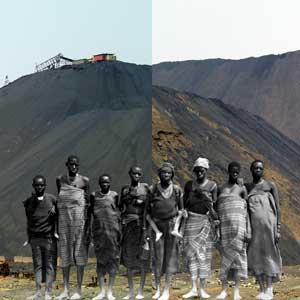Remembering “The Beautiful Time” at the Natural History Museum
Congolese artist Sammy Baloji challenges his nation’s collective memory with collages that meld the past and present, on view at the Natural History Museum
/https://tf-cmsv2-smithsonianmag-media.s3.amazonaws.com/filer/20120124025003balojithumb.jpg)
In Sammy Baloji’s native Congo, the mid-20th century is wistfully remembered as la belle époque, or the beautiful time. During the colonial era of the 1930s and 1940s, skilled Congolese laborers built a thriving copper mining industry that turned the city of Lubumbashi into a modernized center of wealth and cosmopolitan culture. This period saw unusual prosperity that permeated all levels of colonial society, from the Dutch colonial industrialists to the black Congolese workers.
This brief moment of universal prosperity is memorialized in “The Beautiful Time: Photography by Sammy Baloji,” now on view at the Natural History Museum. Baloji’s photographic collages superimpose this heyday of the past with the desolation of the present. The copper mines of today, abandoned and dormant, become backdrops for archival black-and-white photographs of mine workers and colonial officials.
What happened in the gap between these two realities? The invisible step—30 years of civil war, the assassination of the first legally elected Prime Minister, Patrice Lumumba, and rampant government corruption—haunts every photograph. “The archival photograph is always in the front plane and the desolation is in the back,” curator Mary Jo Arnoldi says. “What’s missing is the memory of those 30 years. He’s celebrating the work of his grandfathers who built this great modern colony, and then he’s indicting his father’s generation who squandered it through the government’s corruption.”
“The Beautiful Time” came to the Natural History Museum from the Museum of African Art in New York City. “I was very interested in it because the permanent exhibit here, “African Voices,” is focused on giving voice to Africans themselves to tell their stories about contemporary Africa and their history, as opposed to the museum always being the voice,” Arnoldi says. She plans to use volunteer facilitators to help direct visitors and explain the links between Baloji’s work and the rest of the African Voices exhibit. “In the permanent exhibit, our main topics are the value of work, how wealth is created, the colonial experience,” Arnoldi says. “And photographs speak to all of these things in a really compelling way. It gives it a visual voice as opposed to just text.”
The colonial industry of Lubumbashi in many ways adds nuance to the conventional history of colonized Africa. “The Belgians invested, but the people who actually did the work were Congolese,” Arnoldi points out. “They became a very skilled group of people. They sent their kids to school and built this very modern city. We’re talking about a very modern population of people with technological skills who are running a pretty sophisticated industry.”
Arnoldi brings a new element to the previous show at the Museum of African Art. She added commentary from Baloji’s fellow Congolese artist and collaborator, poet Patrick Mudekereza, to flesh out the story beyond the cold historical facts. According to Mudekereza, Baloji is challenging the romantic narrative of the period. “Sammy’s photographs are not nostalgic celebrations of the beautiful time, which is a phrase we often hear the older generation use when referring to the golden age of the colonial mining industry,” Mudekereza writes in one of the show’s inscriptions. “Rather, his pictures speak to today, implying a failure by our leaders to provide our people with a means to create a more beautiful time than before.”
Noticeably, there are no contemporary Congolese people in the photographs. Baloji avoids the use of city’s current inhabitants because he wants them to be active viewers of the history he depicts. As Arnoldi says, “These are directed to a global art audience, but also directed very specifically to a young Congolese audience, to his generation.”
Inscribed on the wall outside the African Voices exhibit is a Sierra Leonean proverb: “Know the road you’ve come down or you can’t know where you’re going.” Arnoldi sees this proverb as central to Baloji’s work. “He’s saying you have to understand your past. You have to understand the past of who built these mines. You have to understand what happened to them,” she says. “In order to move forward, you have to own your history.”
The Beautiful Time: Photography by Sammy Baloji opened on January 7th and runs through 2012 at the Natural History Museum.
/https://tf-cmsv2-smithsonianmag-media.s3.amazonaws.com/accounts/headshot/ATM-aviva-shen-240.jpg)

/https://tf-cmsv2-smithsonianmag-media.s3.amazonaws.com/accounts/headshot/ATM-aviva-shen-240.jpg)